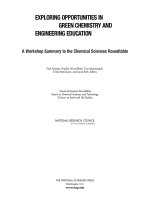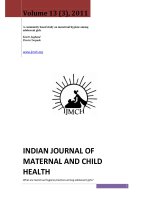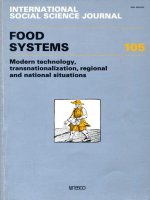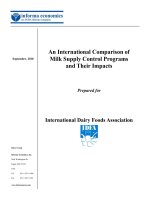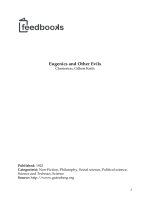Improving Mathematics and Science Education pot
Bạn đang xem bản rút gọn của tài liệu. Xem và tải ngay bản đầy đủ của tài liệu tại đây (595.88 KB, 117 trang )
This document and trademark(s) contained herein are protected by law
as indicated in a notice appearing later in this work. This electronic
representation of RAND intellectual property is provided for non-
commercial use only. Permission is required from RAND to reproduce, or
reuse in another form, any of our research documents.
Limited Electronic Distribution Rights
Visit RAND at www.rand.org
Explore RAND Education
View document details
For More Information
This PDF document was made available
from www.rand.org as a public service of
the RAND Corporation.
6
Jump down to document
THE ARTS
CHILD POLICY
CIVIL JUSTICE
EDUCATION
ENERGY AND ENVIRONMENT
HEALTH AND HEALTH CARE
INTERNATIONAL AFFAIRS
NATIONAL SECURITY
POPULATION AND AGING
PUBLIC SAFETY
SCIENCE AND TECHNOLOGY
SUBSTANCE ABUSE
TERRORISM AND
HOMELAND SECURITY
TRANSPORTATION AND
INFRASTRUCTURE
WORKFORCE AND WORKPLACE
The RAND Corporation is a nonprofit
research organization providing
objective analysis and effective
solutions that address the challenges
facing the public and private sectors
around the world.
Purchase this document
Browse Books & Publications
Make a charitable contribution
Support RAND
This product is part of the RAND Corporation monograph series.
RAND monographs present major research findings that address the
challenges facing the public and private sectors. All RAND mono-
graphs undergo rigorous peer review to ensure high standards for
research quality and objectivity.
Vi-Nhuan Le, Brian M. Stecher, J. R. Lockwood, Laura S. Hamilton,
Abby Robyn, Valerie L. Williams, Gery Ryan, Kerri A. Kerr,
José Felipe Martínez, Stephen P. Klein
Sponsored by the National Science Foundation
Improving
Mathematics and
Science Education
A Longitudinal Investigation of the
Relationship Between Reform-Oriented
Instruction and Student Achievement
The RAND Corporation is a nonprofit research organization providing
objective analysis and effective solutions that address the challenges
facing the public and private sectors around the world. RAND’s
publications do not necessarily reflect the opinions of its research clients
and sponsors.
R
®
is a registered trademark.
© Copyright 2006 RAND Corporation
All rights reserved. No part of this book may be reproduced in any
form by any electronic or mechanical means (including photocopying,
recording, or information storage and retrieval) without permission in
writing from RAND.
Published 2006 by the RAND Corporation
1776 Main Street, P.O. Box 2138, Santa Monica, CA 90407-2138
1200 South Hayes Street, Arlington, VA 22202-5050
4570 Fifth Avenue, Suite 600, Pittsburgh, PA 15213-2665
RAND URL: />To order RAND documents or to obtain additional information, contact
Distribution Services: Telephone: (310) 451-7002;
Fax: (310) 451-6915; Email:
Library of Congress Cataloging-in-Publication Data
Improving mathematics and science education : a longitudinal investigation of the
relationship between reform-oriented instruction and student achievement /
Vi-Nhuan Le [et al.].
p. cm.
Includes bibliographical references.
ISBN-13: 978-0-8330-3964-4 (pbk. : alk. paper)
1. Mathematics—Study and teaching (Elementary)—United States. 2. Science—
Study and teaching (Elementary)—United States. 3. Education—Aims and
objectives—United States. 4. Academic achievement—United States.
I. Le, Vi-Nhuan.
QA135.6.I47 2006
372.7—dc22
2006016941
The research described in this report was sponsored by the National
Science Foundation and was conducted by RAND Education, a unit of
the RAND Corporation.
iii
Preface
e term reform-oriented teaching describes a collection of instructional
practices that are designed to engage students as active participants in
their own learning and to enhance the development of complex cog-
nitive skills and processes. is monograph presents the results of a
multiyear, National Science Foundation (NSF)-funded study of the
effect of reform-oriented mathematics and science teaching on student
achievement.
e research was conducted in three districts that participated in
the NSF Local Systemic Change program, although the study is not an
evaluation of the implementation or impact of that specific program.
By following students for three years and by using innovative measures
of practice, this study extends prior RAND research on mathematics
and science instructional practices:
S. Klein, L. Hamilton, D. McCaffrey, B. Stecher, A. Robyn,
and D. Burroughs, Teaching Practices and Student Achievement:
Report of First-Year Findings from the “Mosaic” Study of Systematic
Initiatives in Mathematics and Science, MR-1233-EDU, 2000.
L. Hamilton, D. McCaffrey, B. Stecher, S. Klein, A. Robyn, and
D. Bugliari, “Studying Large-Scale Reforms of Instructional
Practice: An Example from Mathematics and Science,” Educational
Evaluation and Policy Analysis, Vol. 25, No. 1, 2003, pp. 1–29.
Results should be of interest to educators and policymakers concerned
with improving mathematics and science education. Appendixes sup-
•
•
porting the results and providing background information are included
on the CD-ROM inside the back cover.
e study was carried out by RAND Education, a unit of the
RAND Corporation, and was sponsored by NSF. It is part of a larger
body of RAND Education work addressing teachers and teaching,
mathematics and science achievement, and instructional reforms.
iv iv Improving Mathematics and Science Education
Preface iii
Figures
ix
Tables
xi
Summary
xiii
Acknowledgments
xxi
Abbreviations
xxiii
CHAPTER ONE
Introduction 1
Background: Reform-Oriented Instruction in Mathematics and Science
1
Focus of the Mosaic II Study
3
Mosaic II Study Design
4
Expanded Measures of Instructional Practice
5
Longitudinal Data and Analysis
6
Multiple Outcome Measures
6
Research Questions
7
Importance of the Study
7
Organization of is Monograph
8
CHAPTER TWO
Sample Selection and Data Collection 9
Site, School, and Grade-Level Selection
9
Data Collection: Student-Achievement Data
13
Data Collection: Teacher Background and Classroom Practice Data
14
Teacher Sur vey
16
Contents
v
vi Improving Mathematics and Science Education
Teacher Logs 17
Vignette-Based Items
18
Classroom Observations
18
Teacher Inter views
20
Cognitive Interviews
21
CHAPTER THREE
Measures of Teaching Practices 23
Measures Derived from Surveys and Logs
23
Instructional Practice Scales
26
Curriculum Coverage Scales
33
Teacher Background Scales
35
Classroom Context Scales
36
Measures Derived from Observations
37
Vignette-Based Measures
38
Developing the Classroom Vignettes
38
Structure of the Vignette-Based Items
39
Measures Derived from Vignettes
41
Validity of Vignette-Based Measures as Indicators of
Reform-Oriented Instruction
42
CHAPTER FOUR
Relationships Between Reform-Oriented Instruction and Student
Achievement in Mathematics and Science
49
Variance in Student-Achievement Scores
49
A Statistical Model to Examine the Relationships Between Student
Achievement, Reform Instruction, and Other Factors
53
Model
55
Implementation Issues
56
Relationships Between Teacher-Level Variables and
Student Achievement
58
Mathematics Results
59
Science Results
66
Explaining the Empirical Results with Teacher Interviews
70
vii
vii
Model Limitations 71
Summary of Findings
72
CHAPTER FIVE
Implications 75
Explaining Weak Relationships
76
Implementing Reform-Oriented Instruction: Where to Go from Here
78
Appendixes
81
References
83
Contents vii
Figures
ix
3.1. Distribution of Teachers’ Responses in Relation to Idealized
Low- and High-Reform-Oriented Teachers, Cohort 1,
Year 2
43
4.1.
Variance Decomposition of Achievement Scores for Each
Year, Cohort, and Outcome
52
4.2. Relationships Between Variables for Instructional Practices,
Curriculum Coverage, Teacher Background, and Classroom
Context and Mathematics Achievement (Single-Year
Exposure)
60
4.3. Relationships Between Variables for Instructional Practices,
Curriculum Coverage, Teacher Background, and Classroom
Context and Mathematics Achievement (Cumulative
Exposure)
61
4.4. Relationships Between Variables for Instructional Practices,
Curriculum Coverage, Teacher Background, and Classroom
Context and Science Achievement (Single-Year Exposure)
67
4.5. Relationships Between Variables for Instructional Practices,
Curriculum Coverage, Teacher Background, and Classroom
Context and Science Achievement (Cumulative Exposure)
68
Tables
xi
2.1. Description of Participating Schools and Grade-Subject
Cohorts
11
2.2. Student Samples
13
2.3a. Achievement Information Obtained for Each Cohort,
Years 0 and 1
15
2.3b. Achievement Information Obtained for Each Cohort,
Years 2 and 3
16
2.4. Description of Data-Collection Instruments
17
2.5. Teacher Survey and Log Response Rate
19
2.6. Number of Teachers Participating in Interviews
20
3.1. List of Scales Created from the Surveys and Logs
24
3.2a. Characteristics of Scales for Instructional Practices,
Curriculum Coverage, Teacher Background, and
Classroom Context for Cohort 1, Year 1
29
3.2b. Characteristics of Scales for Instructional Practices,
Curriculum Coverage, Teacher Background, and
Classroom Context for Cohort 1, Year 2
30
3.2c. Characteristics of Scales for Instructional Practices,
Curriculum Coverage, Teacher Background, and
Classroom Context for Cohort 1, Year 3
32
3.3. Distribution of “Yes” Responses for Dichotomous Scales for
Teacher Background and Classroom Context in Cohort 1
36
xiii
Summary
Background and Purpose
Reform-oriented teaching is a collection of instructional practices that
was a prominent feature of reforms in mathematics and science edu-
cation beginning in the 1990s. Such practices, which are consistent
with the National Science Education Standards (National Research
Council, 1996), stressed instruction that engages students as active
participants in their own learning and emphasizes the development of
complex cognitive skills and processes. Despite large investments in the
promotion of reform-oriented curricula and instruction, the evidence
supporting the effectiveness of these practices in raising mathematics
and science achievement is relatively weak.
is monograph presents the findings of a multiyear study of the
effectiveness of reform-oriented mathematics and science instruction.
It builds on an earlier RAND study, called the Mosaic project, which
found “a weak but positive relationship” between reform practices and
student achievement (see Klein, Hamilton, McCaffrey, Stecher, Robyn,
and Burroughs, 2000; Hamilton, McCaffrey, Stecher, Klein, Robyn,
and Bugliari, 2003). e present study, called Mosaic II, extends this
earlier research in two important ways. First, it incorporates more-
diverse indicators of student exposure to reform-oriented practices,
including innovative, vignette-based measures. Second, it follows stu-
dents for three years to measure the relationship after longer exposure.
Similar to the earlier research, this study uses multiple measures of
achievement, including open-ended assessments, to determine whether
the relationship is sensitive to the manner in which achievement is
measured.
Mosaic II was designed to answer two major research questions:
Is the use of reform-oriented instructional practices in mathemat-
ics and science associated with higher student achievement?
Is the relationship between reform-oriented practices and achieve-
ment sensitive to the aspects of achievement that are measured?
Methods
Mosaic II is an observational study, relying on naturally occurring
variation in teaching practices as the basis for uncovering relationships
between reform-oriented practice and student outcomes. at is, the
design assumes that there is substantial variation in teaching practices
among teachers within a school, even though teachers may have been
exposed to the same training. To find a sample of teachers that encom-
passed a range of different instructional approaches, including reform-
oriented instruction, we selected three districts that had recently con-
cluded their participation in the Local Systemic Change program, a
five-year National Science Foundation initiative to promote reform-
oriented, systemic reform of mathematics and science education.
Within these three districts, we selected five cohorts of students and
followed each for three years beginning in the 2001–2002 school year.
e cohorts varied in student age and academic subject being studied,
with mathematics examined in three cohorts (grades 3 through 5; 6
through 8; and 7 through 9) and science examined in the remaining
two cohorts (grades 3 through 5 and 6 through 8). All the teachers
who were responsible for teaching the targeted subject (mathematics or
science) to students in the five cohorts were included in the research in
the year or years they taught the subject to the students.
For all five cohorts, achievement was measured using the math-
ematics or science component of the Stanford Achievement Test Series,
Ninth Edition (SAT-9), published by Harcourt Assessment. For most
•
•
xiv Improving Mathematics and Science Education
analyses, only the total score was available. However, for one mathe-
matics cohort, we also obtained the Problem-Solving and Mathematical
Procedures subscale scores. In addition, in two science cohorts and one
mathematics cohort, we administered the open-ended version of the
SAT-9 so that we could compare students’ performance on open-ended
and multiple-choice measures.
A key feature of the Mosaic II study is the use of multiple mea-
sures to determine the extent to which reform-oriented teaching prac-
tices were being used in the classroom. Each year, all participating
teachers completed a survey, filled out classroom logs, and responded
to a set of vignette-based questions about instructional practices. In
selected years, we supplemented the main data-collection procedures
with classroom observations and interviews conducted with a smaller
subset of teachers. We used teacher responses to the surveys, logs, and
vignettes, and observers’ ratings of classrooms to derive a number of
measures of instructional practices, teacher background, curriculum
coverage, and classroom context.
One of the innovative features of this study is the use of vignette-
based measures of instructional practice. Vignettes are contextualized
descriptions of hypothetical classroom situations that can be used to
elicit information about potential teaching behaviors. In this study,
vignette-based items were used to try to ascertain teachers’ tenden-
cies to use reform-oriented instructional practices. We developed two
vignettes for each subject-grade combination. Each vignette contained
four instructional problems that provided teachers with hypothetical
classroom events at different points within the given mathematics or
science unit.
After each instructional problem, teachers were presented with a
list of options that reflected a range of teaching actions, from behav-
iors that were not associated with reform pedagogy to teacher behav-
iors that were consistent with reform-oriented teaching. Teachers were
asked to rate their likelihood of engaging in each option, using a four-
point scale from “very unlikely” to “very likely,” or, for questions of
emphasis, from “no emphasis” to “great emphasis.”
We derived two measures from the vignettes. e first mea-
sure, Reform-High, reflects teachers’ answers to the subset of high-
Summary xv
reform response options across the two vignettes. e second measure,
Reform-Full, reflects the “location” of each teacher between an “ideal”
high-reform teacher and an “ideal” nonreform teacher. e ideal high-
reform teacher was a simulated teacher whose self-reported likelihood
of engaging in each option corresponded exactly to our judgments
of reform orientation. Conversely, the ideal nonreform teacher was a
simulated teacher whose self-reported likelihood was just the opposite.
Analyses of the pattern of responses to these and other measures, as
well as cognitive interviews conducted with a subset of teachers who
described their thought processes as they answered the vignettes, sug-
gest that the measures are providing some validity evidence about the
likely use of reform-oriented instruction. e cognitive interviews also
provided insights to inform potential improvements to the vignettes.
We used a multivariate linear mixed model to represent the rela-
tionship between longitudinal exposure to teacher-level predictors and
student-achievement trajectories. For each outcome in each cohort, we
jointly modeled test scores from the three years of the study. Scores
were expressed as a linear function of overall means, adjustments for
student-background variables and prior performance, current and
past exposure to teacher-level predictors, unobserved random teacher
effects, and residual errors that were allowed to be correlated across
time within (i.e., for each) student.
We estimated the effects of teacher-level variables, including
instructional practices, one at a time. at is, we started with a baseline
model that includes adjustments for student demographics and year 0
(the year before the study began) achievement, and then examined the
effects of a given individual teacher-level variable by augmenting the
baseline model with only that particular teacher-level variable.
We report inferences about two functions of the model param-
eters that quantify the effects of exposure to teacher-level variables on
student achievement. e first function captures the average effect of
current-year exposure on current-year outcomes. e other function is
the three-year cumulative exposure effect, which is interpreted as the
expected difference in the scores between two students, one of whom
xvi Improving Mathematics and Science Education
received above-average exposure to the particular teacher-level variable
under consideration for three consecutive years, and the other one of
whom received average exposure for three consecutive years.
Study Limitations
Although this study represents a methodological advance in compari-
son with earlier studies, it still has limitations. Stronger conclusions
would have been possible using an experimental design rather than
relying on naturally occurring variation. In particular, we had no con-
trol of the assignment of students to teachers during the three years
of the research, and, as a result, relatively few students received either
the most intensive or the least intensive exposure to reform-oriented
instruction. Tracking of students in the middle schools may have con-
founded achievement with exposure in ways we were unable to disen-
tangle. More-extensive use of classroom observations might provide a
more accurate indication of teaching practices than do the self-report
measures that were the primary tool in this study. Our experience
using the vignette-based measures revealed ways these vignette-based
measures might be improved in the future, as well.
Relationships Between Reform-Oriented Instruction and
Student Achievement
e first research question concerned the relationships between expo-
sure to reform practices and student achievement. We found that expo-
sure to reform-oriented instruction generally had nonsignificant or
weak positive relationships to student achievement in both mathemat-
ics and science, with the exception of groupwork-related practices in
mathematics (for which the relationships were negative). Additionally,
the findings suggest that relationships tend to become stronger with
sustained exposure to reform teaching.
e second research question asked whether the relationship was
affected by the way achievement was measured. We generally found
Summary xvii
stronger relationships for open-ended measures than for multiple-
choice measures in the sites at which both types of assessment were
administered. Moreover, in the cohort with data on subscales of the
multiple-choice mathematics achievement test, we found positively
signed relationships to the Problem-Solving subscale and negatively
signed relationships to the Procedures subscale. Together, these find-
ings suggest that relationships between instruction and achievement
can depend on how achievement is measured.
Implications
We found nonsignificant or weak positive relationships between
reform-oriented instruction in mathematics and science and student
achievement measured using multiple-choice tests. e relationships
were somewhat stronger when achievement was measured with open-
ended assessment. Additionally, in mathematics, relationships tended
to be positively signed with problem-solving scores.
ese findings confirm previous estimates of weak positive asso-
ciations between reform-oriented instruction and achievement. e
results also reinforce the message that measurement matters—i.e.,
that the observed relationship between reform-oriented instruction
and achievement may depend on how achievement is measured. It is
common practice to use existing state or district tests as measures of
program effectiveness, because it is often not feasible to administer
additional tests. Our analysis indicates that this decision may influence
findings. It also suggests that using subscales from an existing test to
produce a more refined analysis of relationships between instruction
and achievement might be a good practice.
It is also important to note the influence of high-stakes account-
ability testing on teaching practices. Teachers reported that the testing
environment influenced their use of reform-oriented practices despite
the training they had received. In particular, many teachers believed
that the reform-oriented practices were likely to be less effective than
other kinds of practices for promoting high scores on state account-
ability tests. Future research on the effectiveness of reform-oriented
xviii Improving Mathematics and Science Education
instruction needs to recognize that instructional reforms are not car-
ried out in a vacuum, and it should examine the broader contextual
factors as well as the specific elements of the intervention.
Perhaps the most important unanswered question regarding
reform-oriented instruction concerns benefits and costs. e mathe-
matics and science initiatives of the 1990s were relatively expensive
(from the perspective of national reforms). And, although they appear to
have had some effects on mathematics and science teaching, this study
did not address whether these changes in practice and the associated
improvements in achievement were worth the cost. us, it is impos-
sible to know whether the strategy was an efficient one and should be
followed in future reforms. A program of research that involves experi-
mental studies with clear delineation of costs would provide a strong
foundation for future decisions about educational reforms.
Summary xix
xxi
Acknowledgments
We are indebted to the many individuals who supported us through-
out this project. We are grateful to Ken Jeddeloh, Carolyn O’Reilly,
and James Myerberg, whose assistance ensured successful coordina-
tion with the schools. We also appreciate the time and insights of the
thousands of students and the hundreds of principals and teachers who
participated in the study.
Our research would not have been possible without input from our
advisory panels. We would like to acknowledge Hilda Borko, Maurene
Flory, Megan Franke, James Middleton, Jody Priselac, Brian Foley,
Maria Lopez-Freeman, Jerome Pine, Kathy Roth, Vandana adani,
and Iris Weiss.
Special thanks go to Miriam Sherin, who served both as an advi-
sory panelist and as our reviewer. Her thoughtful comments and sug-
gestions on earlier drafts of the monograph greatly improved the final
product. We would also like to thank Alicia Alonzo for her help in
developing the vignettes.
A number of RAND colleagues supported us at various stages
of this project. We were fortunate to have the programming skills of
Delia Bugliari and the logistical help of Peter Scott. Derrick Chau
proved invaluable with the vignette development and teacher inter-
views. Donna White, Sharon Koga, and Natalie Swenson provided
much-needed assistance throughout the project. e quality of this
monograph also benefited from the careful reading of Richard Buddin
and Cathy Stasz, both of whom provided incisive comments on earlier
versions.
Finally, special thanks go to Janice Earle for her help and encour-
agement, and to the National Science Foundation for its support of
this project.
xxii Improving Mathematics and Science Education
xxiii
Abbreviations
AAAS American Association for the Advancement of
Science
FOSS Full Option Science System
FRL free or reduced-price lunches
HLM hierarchical linear modeling
LSC Local Systemic Change
MC multiple choice
NAEP National Assessment of Educational Progress
NCTM National Council of Teachers of Mathematics
NRC National Research Council
NSF National Science Foundation
OE open ended
PR procedures
PS problem solving

